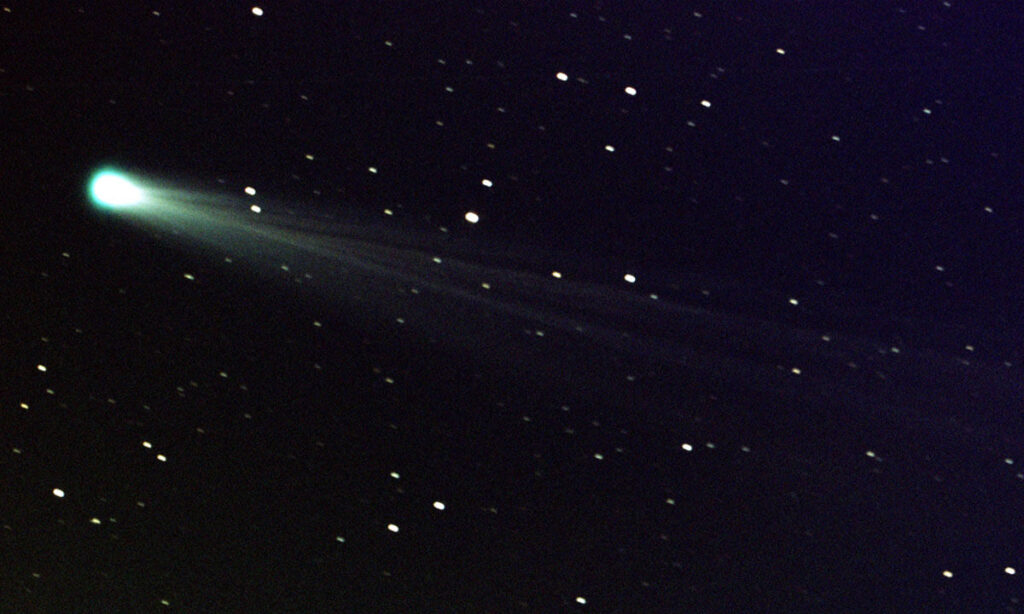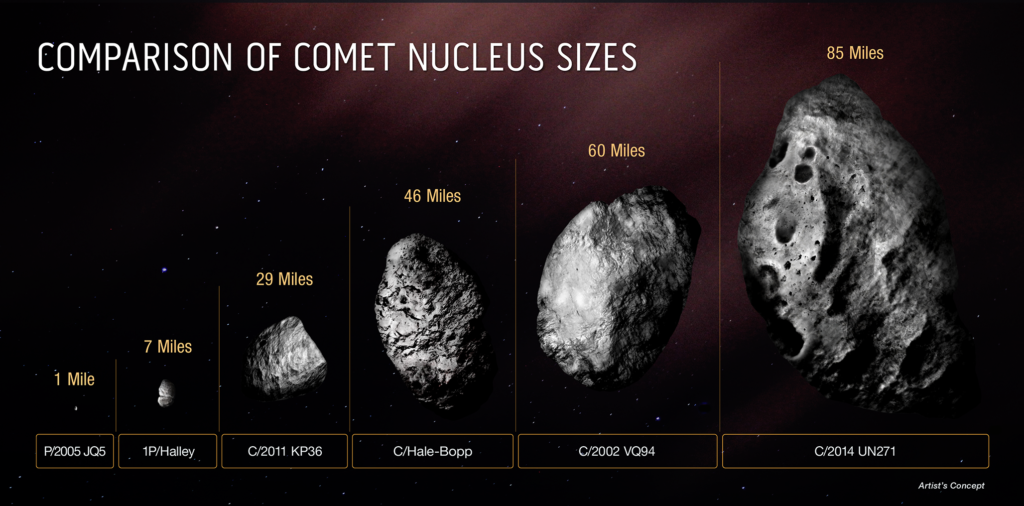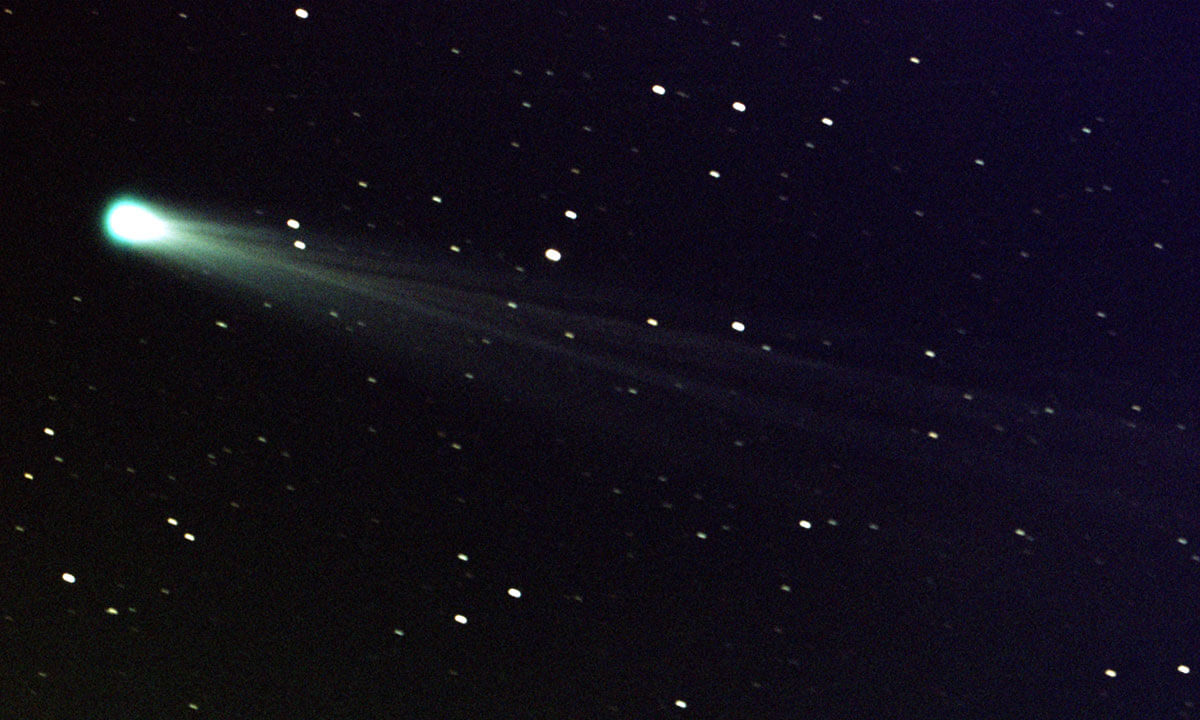Comets are cosmic snowballs composed of ice, dust, and rock. Unlike asteroids, which reside mainly in the asteroid belt, comets originate from the far reaches of our solar system.
Comets’ Size are between a few and tens of miles across, but when they approach the Sun, they heat up and release gases and dust into what may sometimes be a bright, planet-sized head.

What is the Origin of the Comets?
Comets primarily hail from two icy reservoirs: the Kuiper Belt beyond Neptune and the Oort Cloud, a sphere-shaped region at the solar system‘s outskirts.
What is the Composition of the Comets?
Comets are made of a small amount of rock, several forms of ice (such as water, carbon dioxide, ammonia, and methane), and a small amount of complex organic compounds. The icy nucleus, a mixture of frozen water, gases like methane and ammonia, and dust particles, forms the core of a comet.
As it approaches the Sun, the ices begin to vaporize, forming a glowing head (coma) and tails of gas and dust.
What is the Internal Structure of the Comets?
Unlike asteroids, which we can probe with spacecraft missions, directly studying the innards of a comet is challenging. However, based on observations and data analysis, scientists have developed a compelling model for a comet’s internal makeup:
Nucleus:
The heart of the comet is the nucleus, a solid, dirty snowball composed primarily of frozen water ice, dust particles, and various frozen gases like methane and ammonia. Estimates suggest the nucleus can range from a few kilometers to tens of kilometers across.
Coma:
The coma is a hazy, cloud-like region surrounding the nucleus. It’s primarily composed of the vaporized ices and dust particles ejected from the nucleus. The pressure from sunlight pushes dust particles away from the Sun, forming a dust tail.
Tails:
Comets boast two distinct tails: a dust tail and an ion tail.
The dust tail, composed of ejected dust particles, stretches away from the Sun due to the radiation pressure.
The ion tail, on the other hand, is composed of ionized gases (electrically charged particles) from the coma.
The solar wind, a stream of charged particles from the Sun, interacts with the coma’s ions, creating a distinct, often blue-colored ion tail that points directly away from the Sun, regardless of the comet’s direction of travel.
Activity: As a comet ventures closer to the Sun, the intensity of sunlight increases. This triggers sublimation, the process where ice transforms directly into gas without becoming a liquid state. The ices in the nucleus begin to vaporize, releasing dust and gases that form the coma, a glowing envelope surrounding the nucleus.

What are the Examples of Comets:
Our solar system has a diverse collection of comets, each with its unique characteristics. Here are a few examples:
Halley’s Comet:
Perhaps the most famous comet, Halley’s Comet holds the distinction of being a periodic visitor, returning to the inner solar system roughly every 75-76 years. Its last close approach was in 1986, and it’s not expected to return for another visit until 2061.
Comet Tempel-Tuttle:
This comet, with its orbital period of around 33 years, is the source of the annual Leonid meteor shower. When Earth passes through the debris field left behind by the comet, we experience a dazzling display of meteors streaking across the night sky.
Comet 67P/Churyumov-Gerasimenko (Churyumov-Gerasimenko Comet):
This “rubber ducky” shaped comet was extensively studied by the Rosetta mission, which became the first spacecraft to orbit a comet’s nucleus. The mission provided valuable insights into cometary composition and activity.
Neowise Comet (C/2020 F3):
This “sungrazer” comet, discovered in March 2020, made a close approach to the Sun in July of that year. The intense heat caused dramatic outbursts of material, creating a spectacular sight for skywatchers who were fortunate enough to observe it.
Great Comet of 1811:
Nicknamed “The Great Comet,” this long-period comet was one of the brightest comets ever recorded. Visible for much of 1811, it was even bright enough to be seen during the day.
Comet 12P/Pons-Brooks (The Devil Comet, Mother of Dragons Comet):
This intriguing comet boasts several nicknames and a fascinating history. Orbiting the Sun roughly every 71 years, it can exhibit dramatic outbursts of gas and dust, causing its appearance to distort and take on a horned or horseshoe shape, hence the “Devil Comet” moniker.
The most recent outburst occurred in 2023, making it briefly visible to the naked eye. Another nickname, “Mother of Dragons Comet,” reflects its association with fiery outbursts. This comet is a reminder of the active nature of these icy wanderers.

What is the Appearance of the Comets?
Comets are most spectacular when near the Sun. The heat triggers the release of gas and dust, forming the coma and a tail stretching millions of kilometers, often visible to the naked eye.
Orbit of Comets:
Most comets have highly elliptical orbits, taking thousands of years to complete a single trip around the Sun. Some, like Halley’s Comet, become periodic visitors, while others are on a one-way journey into the solar system.
When are Comets visible?
Comets only approach the sun once every few thousand or even million years, spending most of their existence in the extremely frigid outer regions of the solar system, far from the sun.
When comets approach the sun, the many varieties of ices on their surfaces begin to sublimate or change from solid to gas, making them the most visible objects in space.
This causes the comet to transform from a tiny, dark rock into a massive, puffed-up cloud of gas and dust, greatly increasing its visibility via telescopes and occasionally even with the naked eye from Earth. A potentially millions-mile-long tail of gas and dust forms from the comet as it warms up, constantly pointing away from the sun.
How are Comets formed?
Comets are tiny ice remnants from when our solar system first formed. They originated in the same disk of gas and dust as the eight planets, but they contain a lot more ice since they formed in extremely frigid areas far from the sun.
Where do Comets come from?
The majority of comets are found in the furthest regions of the solar system, which is where we sometimes view them in the night sky. The Oort Cloud is this area, which stretches almost halfway from the Kuiper Belt to the nearest star.
Comets have orbits that last millions of years, during which they can travel up to hundreds of thousands of times the distance between the Earth and the sun.
What is the Significance of Comets?
Comets are considered leftover building blocks from the solar system’s formation. Studying them offers insights into the early history of our solar system and the potential for the existence of water ice and organic molecules elsewhere.
Difference between Comets and Asteroids:
Comets Vs. Asteroids
| Feature | Comets | Asteroids |
|---|---|---|
| Composition | Primarily ice (water, methane, ammonia) mixed with dust and rock | Primarily rock and metal |
| Appearance | Develop a fuzzy coma (atmosphere) and tail when they approach the Sun | Mostly rocky in appearance, with some variations in color and surface features |
| Origin | Formed in the outer fringes of the solar system (Kuiper Belt and Oort Cloud) | Formed closer to the Sun during the solar system’s formation, in the asteroid belt between Mars and Jupiter |
| Orbit | Elliptical orbits, often highly inclined compared to the plane of the planets | Varied orbits, with some asteroids following nearly circular paths |
| Activity | Develop comas and tails when near the Sun due to ice sublimation | Generally inactive, with no atmosphere or tail |
| Meteoroids | When a comet breaks apart, its pieces become meteoroids. If they enter Earth’s atmosphere and burn up, they create meteors (shooting stars) | Collisions or explosions can break asteroids into smaller pieces, which become meteoroids. If they enter Earth’s atmosphere and burn up, they create meteors (shooting stars) |
Conclusion:
Comets, with their icy hearts and majestic tails, continue to amaze scientists and skywatchers. As we delve deeper into their internal structure, we gain a better understanding of their role in the formation of our solar system and the potential for the existence of water and organic molecules in these celestial wanderers.
